Strategic Analysis of Tesco PLC: Strategic Plan Evaluation Report
VerifiedAdded on 2022/11/23
|11
|2828
|341
Report
AI Summary
This report provides a comprehensive strategic analysis of Tesco PLC, a leading global retailer. It begins with an introduction to strategic analysis and its importance for business development. The report then delves into the internal and external environments of Tesco using SWOT, Porter's Five Forces, and PESTEL frameworks to identify strengths, weaknesses, opportunities, and threats. The analysis covers Tesco's competitive position, market dynamics, and the influence of political, economic, social, technological, environmental, and legal factors. A strategic choice, competitive pricing, is proposed, followed by recommendations for implementation, including strategies for increasing customer base and loyalty. The report concludes by summarizing the key findings and emphasizing the significance of strategic planning in the retail industry. The report also analyzes leadership and change complexities in the implementation of the strategic plan.
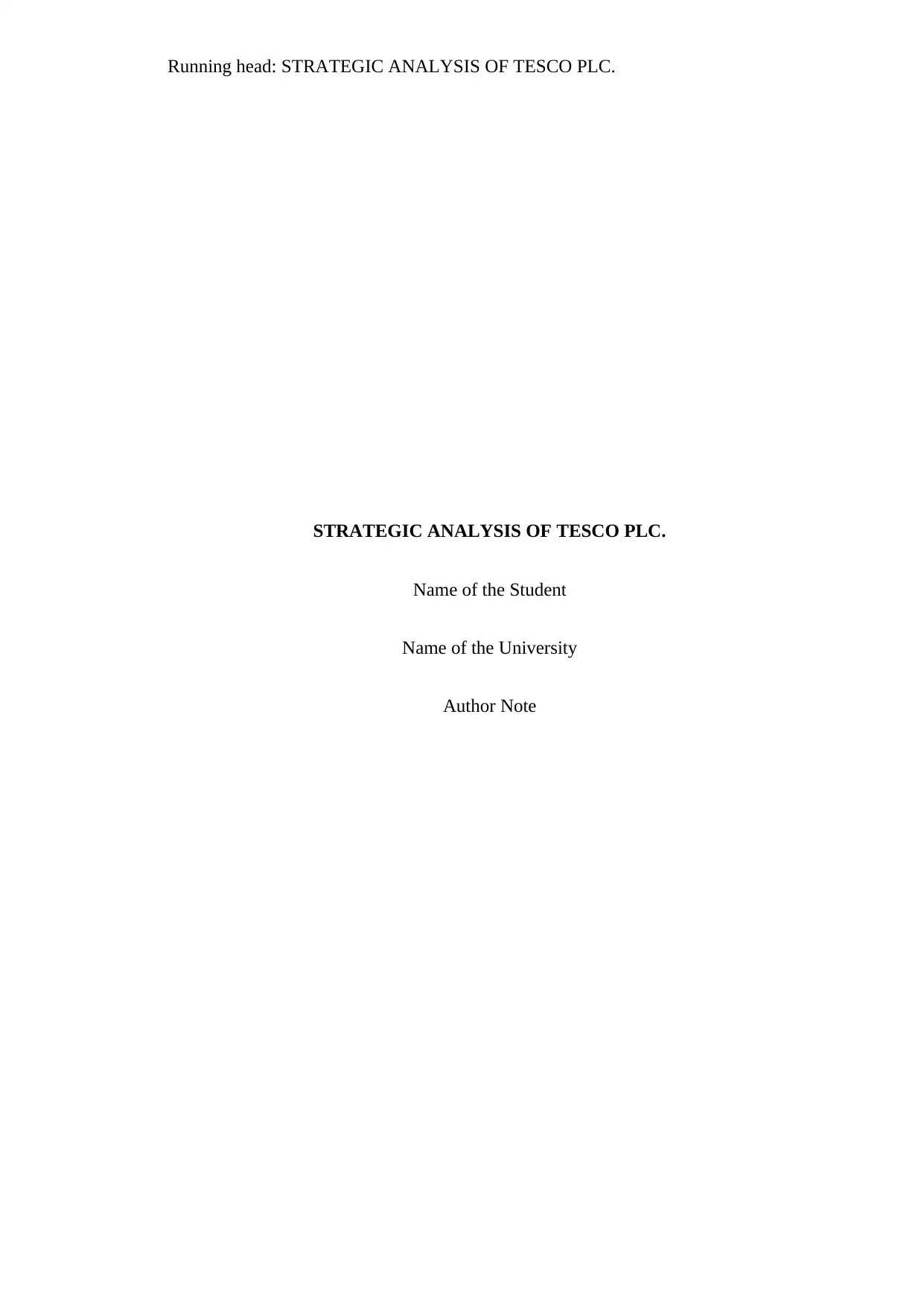
Running head: STRATEGIC ANALYSIS OF TESCO PLC.
STRATEGIC ANALYSIS OF TESCO PLC.
Name of the Student
Name of the University
Author Note
STRATEGIC ANALYSIS OF TESCO PLC.
Name of the Student
Name of the University
Author Note
Paraphrase This Document
Need a fresh take? Get an instant paraphrase of this document with our AI Paraphraser
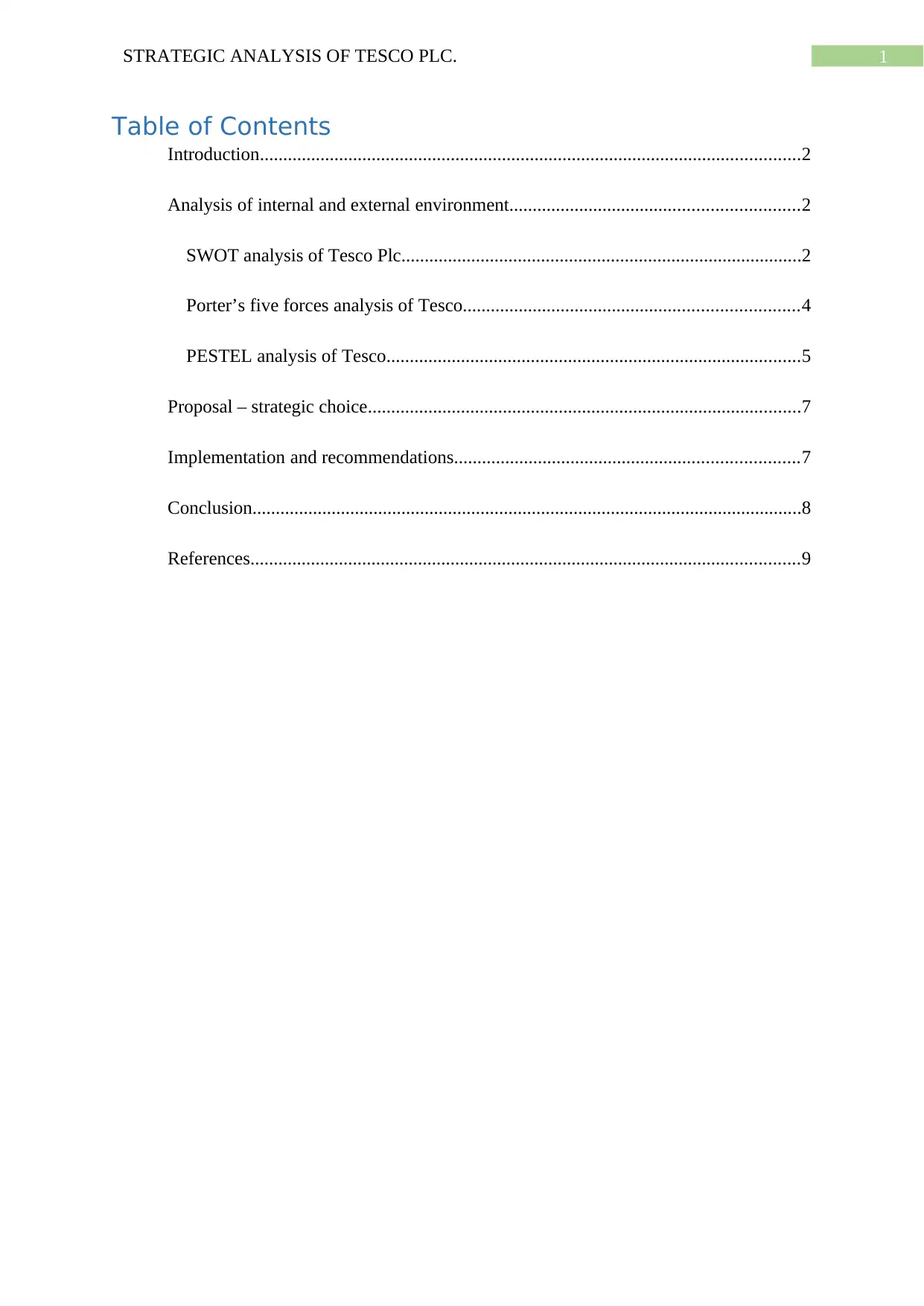
1STRATEGIC ANALYSIS OF TESCO PLC.
Table of Contents
Introduction....................................................................................................................2
Analysis of internal and external environment..............................................................2
SWOT analysis of Tesco Plc......................................................................................2
Porter’s five forces analysis of Tesco........................................................................4
PESTEL analysis of Tesco.........................................................................................5
Proposal – strategic choice.............................................................................................7
Implementation and recommendations..........................................................................7
Conclusion......................................................................................................................8
References......................................................................................................................9
Table of Contents
Introduction....................................................................................................................2
Analysis of internal and external environment..............................................................2
SWOT analysis of Tesco Plc......................................................................................2
Porter’s five forces analysis of Tesco........................................................................4
PESTEL analysis of Tesco.........................................................................................5
Proposal – strategic choice.............................................................................................7
Implementation and recommendations..........................................................................7
Conclusion......................................................................................................................8
References......................................................................................................................9
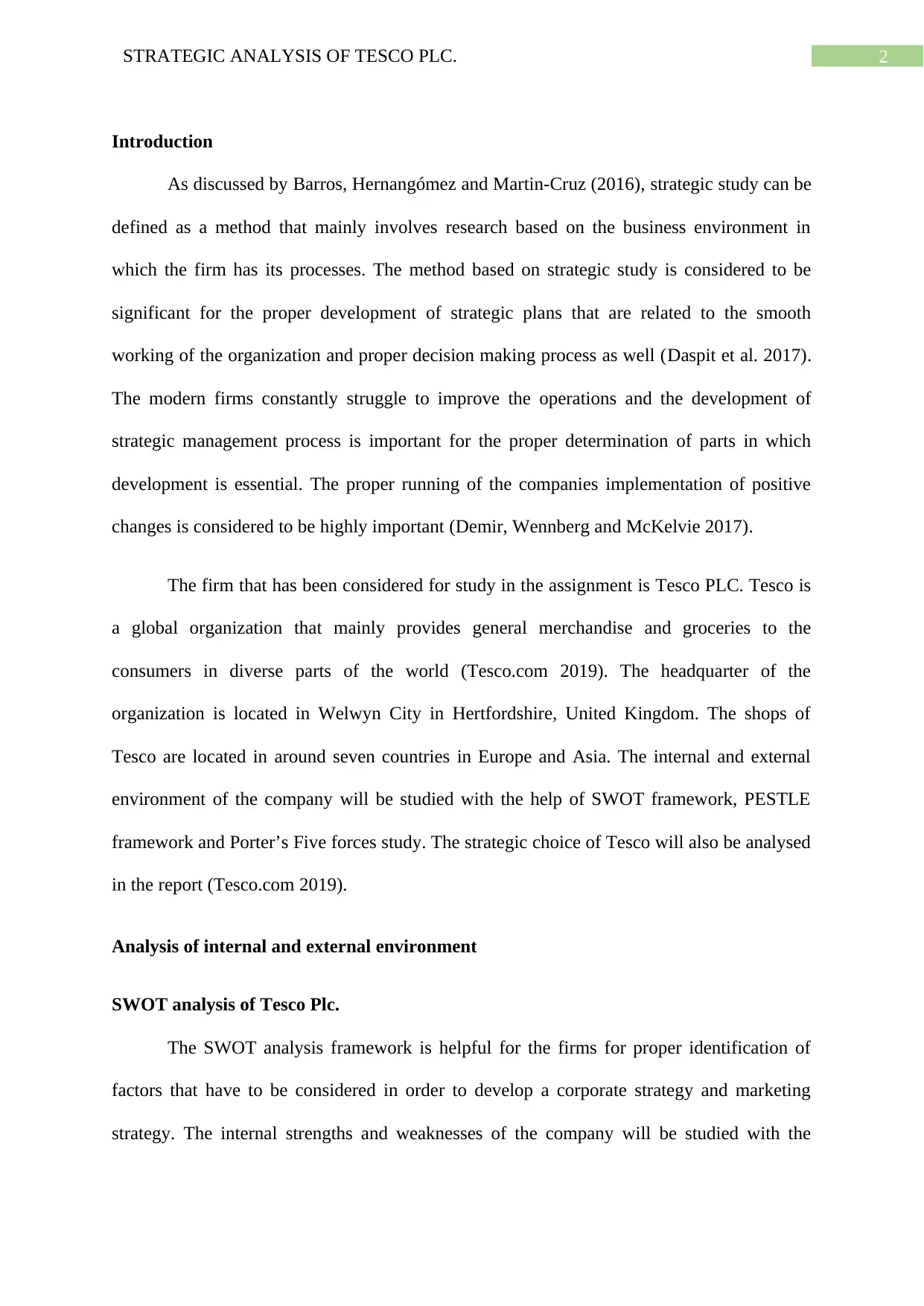
2STRATEGIC ANALYSIS OF TESCO PLC.
Introduction
As discussed by Barros, Hernangómez and Martin-Cruz (2016), strategic study can be
defined as a method that mainly involves research based on the business environment in
which the firm has its processes. The method based on strategic study is considered to be
significant for the proper development of strategic plans that are related to the smooth
working of the organization and proper decision making process as well (Daspit et al. 2017).
The modern firms constantly struggle to improve the operations and the development of
strategic management process is important for the proper determination of parts in which
development is essential. The proper running of the companies implementation of positive
changes is considered to be highly important (Demir, Wennberg and McKelvie 2017).
The firm that has been considered for study in the assignment is Tesco PLC. Tesco is
a global organization that mainly provides general merchandise and groceries to the
consumers in diverse parts of the world (Tesco.com 2019). The headquarter of the
organization is located in Welwyn City in Hertfordshire, United Kingdom. The shops of
Tesco are located in around seven countries in Europe and Asia. The internal and external
environment of the company will be studied with the help of SWOT framework, PESTLE
framework and Porter’s Five forces study. The strategic choice of Tesco will also be analysed
in the report (Tesco.com 2019).
Analysis of internal and external environment
SWOT analysis of Tesco Plc.
The SWOT analysis framework is helpful for the firms for proper identification of
factors that have to be considered in order to develop a corporate strategy and marketing
strategy. The internal strengths and weaknesses of the company will be studied with the
Introduction
As discussed by Barros, Hernangómez and Martin-Cruz (2016), strategic study can be
defined as a method that mainly involves research based on the business environment in
which the firm has its processes. The method based on strategic study is considered to be
significant for the proper development of strategic plans that are related to the smooth
working of the organization and proper decision making process as well (Daspit et al. 2017).
The modern firms constantly struggle to improve the operations and the development of
strategic management process is important for the proper determination of parts in which
development is essential. The proper running of the companies implementation of positive
changes is considered to be highly important (Demir, Wennberg and McKelvie 2017).
The firm that has been considered for study in the assignment is Tesco PLC. Tesco is
a global organization that mainly provides general merchandise and groceries to the
consumers in diverse parts of the world (Tesco.com 2019). The headquarter of the
organization is located in Welwyn City in Hertfordshire, United Kingdom. The shops of
Tesco are located in around seven countries in Europe and Asia. The internal and external
environment of the company will be studied with the help of SWOT framework, PESTLE
framework and Porter’s Five forces study. The strategic choice of Tesco will also be analysed
in the report (Tesco.com 2019).
Analysis of internal and external environment
SWOT analysis of Tesco Plc.
The SWOT analysis framework is helpful for the firms for proper identification of
factors that have to be considered in order to develop a corporate strategy and marketing
strategy. The internal strengths and weaknesses of the company will be studied with the
⊘ This is a preview!⊘
Do you want full access?
Subscribe today to unlock all pages.

Trusted by 1+ million students worldwide
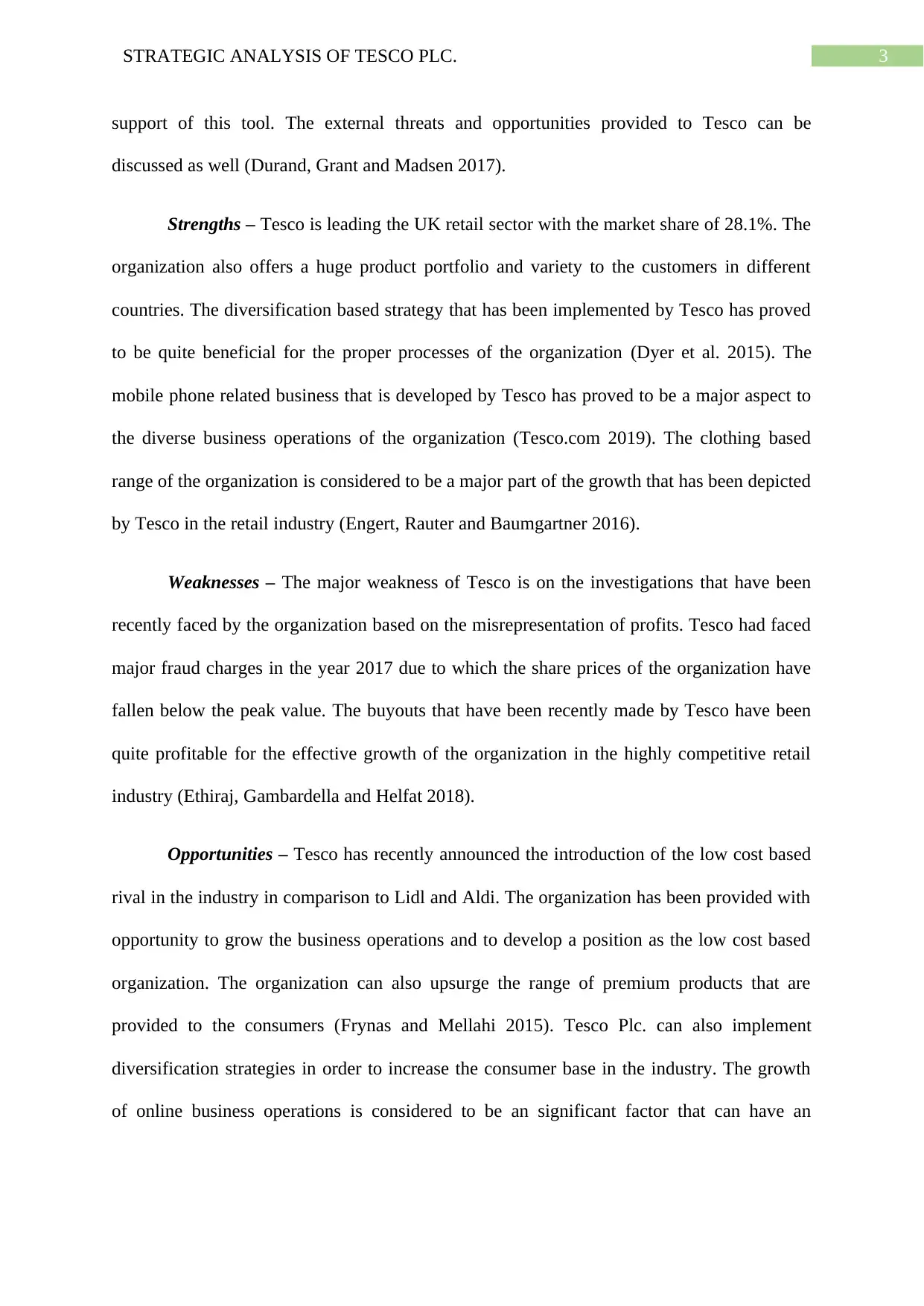
3STRATEGIC ANALYSIS OF TESCO PLC.
support of this tool. The external threats and opportunities provided to Tesco can be
discussed as well (Durand, Grant and Madsen 2017).
Strengths – Tesco is leading the UK retail sector with the market share of 28.1%. The
organization also offers a huge product portfolio and variety to the customers in different
countries. The diversification based strategy that has been implemented by Tesco has proved
to be quite beneficial for the proper processes of the organization (Dyer et al. 2015). The
mobile phone related business that is developed by Tesco has proved to be a major aspect to
the diverse business operations of the organization (Tesco.com 2019). The clothing based
range of the organization is considered to be a major part of the growth that has been depicted
by Tesco in the retail industry (Engert, Rauter and Baumgartner 2016).
Weaknesses – The major weakness of Tesco is on the investigations that have been
recently faced by the organization based on the misrepresentation of profits. Tesco had faced
major fraud charges in the year 2017 due to which the share prices of the organization have
fallen below the peak value. The buyouts that have been recently made by Tesco have been
quite profitable for the effective growth of the organization in the highly competitive retail
industry (Ethiraj, Gambardella and Helfat 2018).
Opportunities – Tesco has recently announced the introduction of the low cost based
rival in the industry in comparison to Lidl and Aldi. The organization has been provided with
opportunity to grow the business operations and to develop a position as the low cost based
organization. The organization can also upsurge the range of premium products that are
provided to the consumers (Frynas and Mellahi 2015). Tesco Plc. can also implement
diversification strategies in order to increase the consumer base in the industry. The growth
of online business operations is considered to be an significant factor that can have an
support of this tool. The external threats and opportunities provided to Tesco can be
discussed as well (Durand, Grant and Madsen 2017).
Strengths – Tesco is leading the UK retail sector with the market share of 28.1%. The
organization also offers a huge product portfolio and variety to the customers in different
countries. The diversification based strategy that has been implemented by Tesco has proved
to be quite beneficial for the proper processes of the organization (Dyer et al. 2015). The
mobile phone related business that is developed by Tesco has proved to be a major aspect to
the diverse business operations of the organization (Tesco.com 2019). The clothing based
range of the organization is considered to be a major part of the growth that has been depicted
by Tesco in the retail industry (Engert, Rauter and Baumgartner 2016).
Weaknesses – The major weakness of Tesco is on the investigations that have been
recently faced by the organization based on the misrepresentation of profits. Tesco had faced
major fraud charges in the year 2017 due to which the share prices of the organization have
fallen below the peak value. The buyouts that have been recently made by Tesco have been
quite profitable for the effective growth of the organization in the highly competitive retail
industry (Ethiraj, Gambardella and Helfat 2018).
Opportunities – Tesco has recently announced the introduction of the low cost based
rival in the industry in comparison to Lidl and Aldi. The organization has been provided with
opportunity to grow the business operations and to develop a position as the low cost based
organization. The organization can also upsurge the range of premium products that are
provided to the consumers (Frynas and Mellahi 2015). Tesco Plc. can also implement
diversification strategies in order to increase the consumer base in the industry. The growth
of online business operations is considered to be an significant factor that can have an
Paraphrase This Document
Need a fresh take? Get an instant paraphrase of this document with our AI Paraphraser
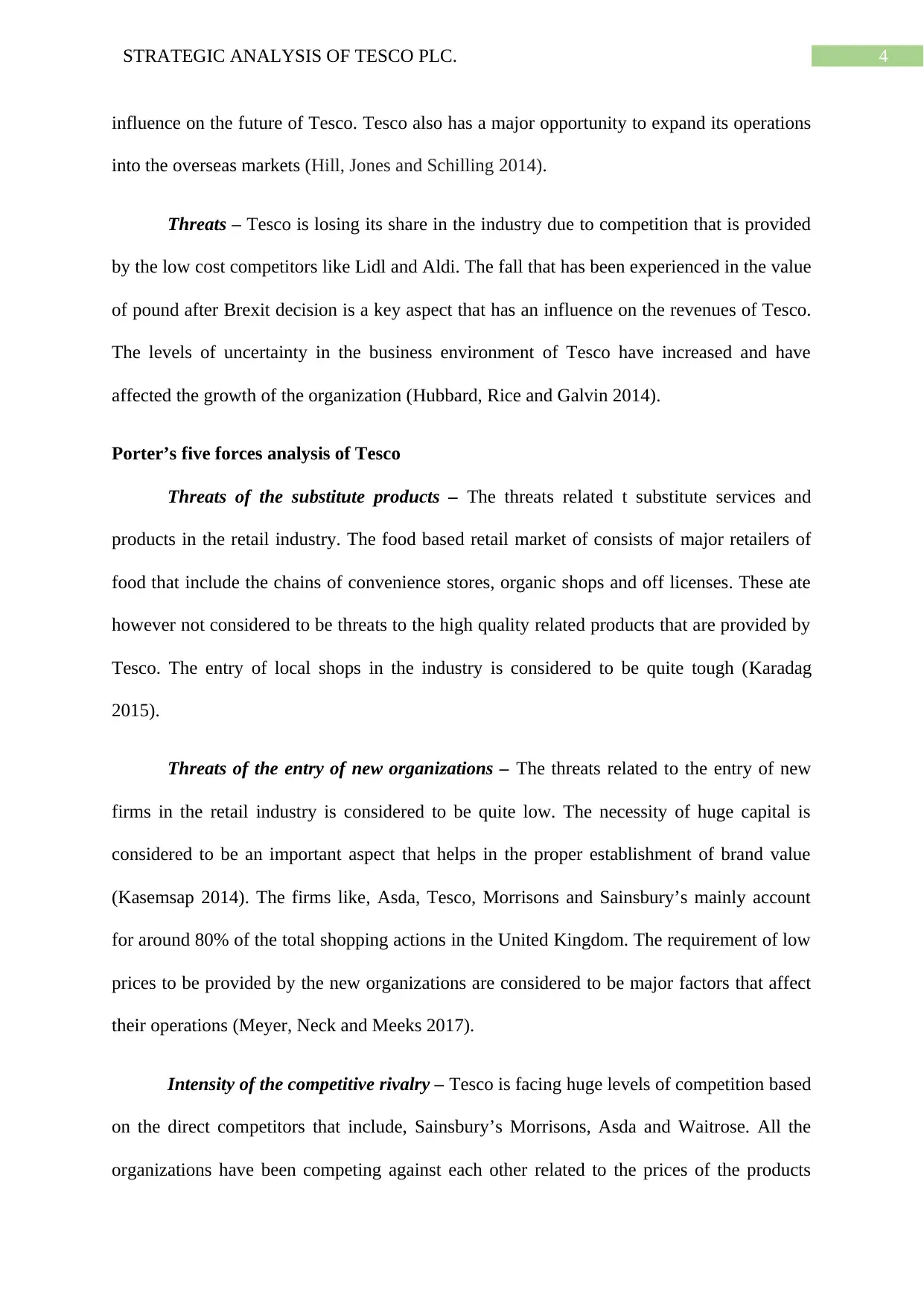
4STRATEGIC ANALYSIS OF TESCO PLC.
influence on the future of Tesco. Tesco also has a major opportunity to expand its operations
into the overseas markets (Hill, Jones and Schilling 2014).
Threats – Tesco is losing its share in the industry due to competition that is provided
by the low cost competitors like Lidl and Aldi. The fall that has been experienced in the value
of pound after Brexit decision is a key aspect that has an influence on the revenues of Tesco.
The levels of uncertainty in the business environment of Tesco have increased and have
affected the growth of the organization (Hubbard, Rice and Galvin 2014).
Porter’s five forces analysis of Tesco
Threats of the substitute products – The threats related t substitute services and
products in the retail industry. The food based retail market of consists of major retailers of
food that include the chains of convenience stores, organic shops and off licenses. These ate
however not considered to be threats to the high quality related products that are provided by
Tesco. The entry of local shops in the industry is considered to be quite tough (Karadag
2015).
Threats of the entry of new organizations – The threats related to the entry of new
firms in the retail industry is considered to be quite low. The necessity of huge capital is
considered to be an important aspect that helps in the proper establishment of brand value
(Kasemsap 2014). The firms like, Asda, Tesco, Morrisons and Sainsbury’s mainly account
for around 80% of the total shopping actions in the United Kingdom. The requirement of low
prices to be provided by the new organizations are considered to be major factors that affect
their operations (Meyer, Neck and Meeks 2017).
Intensity of the competitive rivalry – Tesco is facing huge levels of competition based
on the direct competitors that include, Sainsbury’s Morrisons, Asda and Waitrose. All the
organizations have been competing against each other related to the prices of the products
influence on the future of Tesco. Tesco also has a major opportunity to expand its operations
into the overseas markets (Hill, Jones and Schilling 2014).
Threats – Tesco is losing its share in the industry due to competition that is provided
by the low cost competitors like Lidl and Aldi. The fall that has been experienced in the value
of pound after Brexit decision is a key aspect that has an influence on the revenues of Tesco.
The levels of uncertainty in the business environment of Tesco have increased and have
affected the growth of the organization (Hubbard, Rice and Galvin 2014).
Porter’s five forces analysis of Tesco
Threats of the substitute products – The threats related t substitute services and
products in the retail industry. The food based retail market of consists of major retailers of
food that include the chains of convenience stores, organic shops and off licenses. These ate
however not considered to be threats to the high quality related products that are provided by
Tesco. The entry of local shops in the industry is considered to be quite tough (Karadag
2015).
Threats of the entry of new organizations – The threats related to the entry of new
firms in the retail industry is considered to be quite low. The necessity of huge capital is
considered to be an important aspect that helps in the proper establishment of brand value
(Kasemsap 2014). The firms like, Asda, Tesco, Morrisons and Sainsbury’s mainly account
for around 80% of the total shopping actions in the United Kingdom. The requirement of low
prices to be provided by the new organizations are considered to be major factors that affect
their operations (Meyer, Neck and Meeks 2017).
Intensity of the competitive rivalry – Tesco is facing huge levels of competition based
on the direct competitors that include, Sainsbury’s Morrisons, Asda and Waitrose. All the
organizations have been competing against each other related to the prices of the products
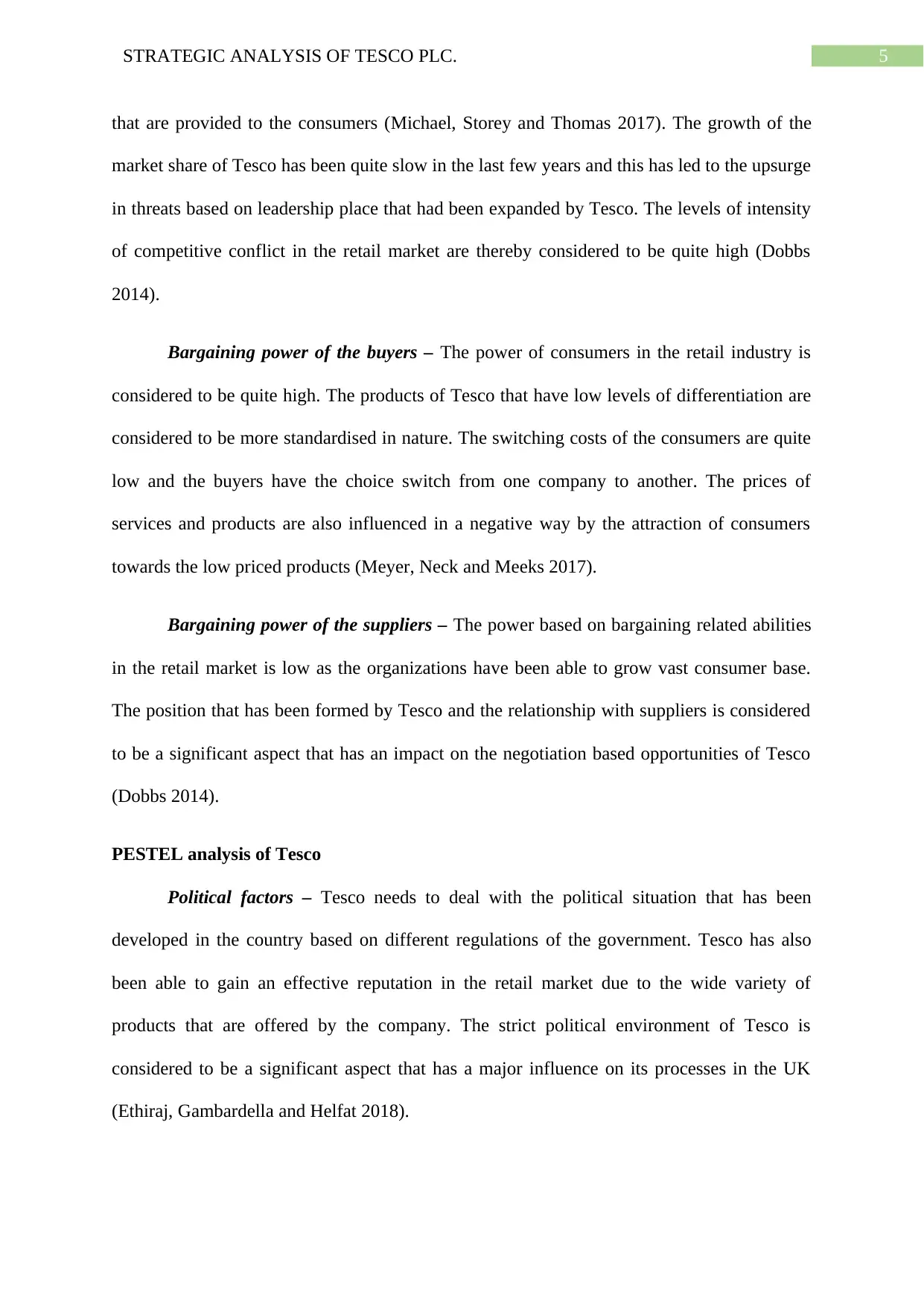
5STRATEGIC ANALYSIS OF TESCO PLC.
that are provided to the consumers (Michael, Storey and Thomas 2017). The growth of the
market share of Tesco has been quite slow in the last few years and this has led to the upsurge
in threats based on leadership place that had been expanded by Tesco. The levels of intensity
of competitive conflict in the retail market are thereby considered to be quite high (Dobbs
2014).
Bargaining power of the buyers – The power of consumers in the retail industry is
considered to be quite high. The products of Tesco that have low levels of differentiation are
considered to be more standardised in nature. The switching costs of the consumers are quite
low and the buyers have the choice switch from one company to another. The prices of
services and products are also influenced in a negative way by the attraction of consumers
towards the low priced products (Meyer, Neck and Meeks 2017).
Bargaining power of the suppliers – The power based on bargaining related abilities
in the retail market is low as the organizations have been able to grow vast consumer base.
The position that has been formed by Tesco and the relationship with suppliers is considered
to be a significant aspect that has an impact on the negotiation based opportunities of Tesco
(Dobbs 2014).
PESTEL analysis of Tesco
Political factors – Tesco needs to deal with the political situation that has been
developed in the country based on different regulations of the government. Tesco has also
been able to gain an effective reputation in the retail market due to the wide variety of
products that are offered by the company. The strict political environment of Tesco is
considered to be a significant aspect that has a major influence on its processes in the UK
(Ethiraj, Gambardella and Helfat 2018).
that are provided to the consumers (Michael, Storey and Thomas 2017). The growth of the
market share of Tesco has been quite slow in the last few years and this has led to the upsurge
in threats based on leadership place that had been expanded by Tesco. The levels of intensity
of competitive conflict in the retail market are thereby considered to be quite high (Dobbs
2014).
Bargaining power of the buyers – The power of consumers in the retail industry is
considered to be quite high. The products of Tesco that have low levels of differentiation are
considered to be more standardised in nature. The switching costs of the consumers are quite
low and the buyers have the choice switch from one company to another. The prices of
services and products are also influenced in a negative way by the attraction of consumers
towards the low priced products (Meyer, Neck and Meeks 2017).
Bargaining power of the suppliers – The power based on bargaining related abilities
in the retail market is low as the organizations have been able to grow vast consumer base.
The position that has been formed by Tesco and the relationship with suppliers is considered
to be a significant aspect that has an impact on the negotiation based opportunities of Tesco
(Dobbs 2014).
PESTEL analysis of Tesco
Political factors – Tesco needs to deal with the political situation that has been
developed in the country based on different regulations of the government. Tesco has also
been able to gain an effective reputation in the retail market due to the wide variety of
products that are offered by the company. The strict political environment of Tesco is
considered to be a significant aspect that has a major influence on its processes in the UK
(Ethiraj, Gambardella and Helfat 2018).
⊘ This is a preview!⊘
Do you want full access?
Subscribe today to unlock all pages.

Trusted by 1+ million students worldwide

6STRATEGIC ANALYSIS OF TESCO PLC.
Economic factors – The economic environment of the United Kingdom has an
influence of the profitability levels of Tesco. Tesco needs to deal with the macro and micro
environment based factors in order to uphold the profitability in the retail market. The per
capita based income that has been gained by the residents of the UK has a key influence on
the business model and operations of Tesco (Frynas and Mellahi 2015).
Social factors – The social condition of the UK is considered to be quite favourable
for the proper operations of Tesco based on its large scale operations. The organization has
already benefitted from the variations that have taken place in the shopping based habits of
the employees. Cultural factors have an influence on the levels of satisfaction of the
customers in retail industry of the United Kingdom (Ethiraj, Gambardella and Helfat 2018).
Technological factors – The technological situation is considered to be quite stable in
the UK retail market. The variations that have taken place in the technologies used in retail
organizations are low. Tesco has been able to align its operations with the technological
variations that have taken place in the retail environment (Durand, Grant and Madsen 2017).
Environmental factors – The natural environment and natural resources are
considered to be extremely significant for the processes of Tesco. The organization has
thereby implemented different practices that are able to support the initiatives implemented
by the government of the United Kingdom and the environmentalists as well (Hubbard, Rice
and Galvin 2014).
Legal factors – The legal environment and factors are considered to be extremely
important for the methods by which Tesco is able to maintain its operations in the retail
industry. The company has been successful in upholding its reputation in the industry due to
the high levels of adherence that the management has to the different policies related to laws
that have been developed by the EU (Ethiraj, Gambardella and Helfat 2018).
Economic factors – The economic environment of the United Kingdom has an
influence of the profitability levels of Tesco. Tesco needs to deal with the macro and micro
environment based factors in order to uphold the profitability in the retail market. The per
capita based income that has been gained by the residents of the UK has a key influence on
the business model and operations of Tesco (Frynas and Mellahi 2015).
Social factors – The social condition of the UK is considered to be quite favourable
for the proper operations of Tesco based on its large scale operations. The organization has
already benefitted from the variations that have taken place in the shopping based habits of
the employees. Cultural factors have an influence on the levels of satisfaction of the
customers in retail industry of the United Kingdom (Ethiraj, Gambardella and Helfat 2018).
Technological factors – The technological situation is considered to be quite stable in
the UK retail market. The variations that have taken place in the technologies used in retail
organizations are low. Tesco has been able to align its operations with the technological
variations that have taken place in the retail environment (Durand, Grant and Madsen 2017).
Environmental factors – The natural environment and natural resources are
considered to be extremely significant for the processes of Tesco. The organization has
thereby implemented different practices that are able to support the initiatives implemented
by the government of the United Kingdom and the environmentalists as well (Hubbard, Rice
and Galvin 2014).
Legal factors – The legal environment and factors are considered to be extremely
important for the methods by which Tesco is able to maintain its operations in the retail
industry. The company has been successful in upholding its reputation in the industry due to
the high levels of adherence that the management has to the different policies related to laws
that have been developed by the EU (Ethiraj, Gambardella and Helfat 2018).
Paraphrase This Document
Need a fresh take? Get an instant paraphrase of this document with our AI Paraphraser
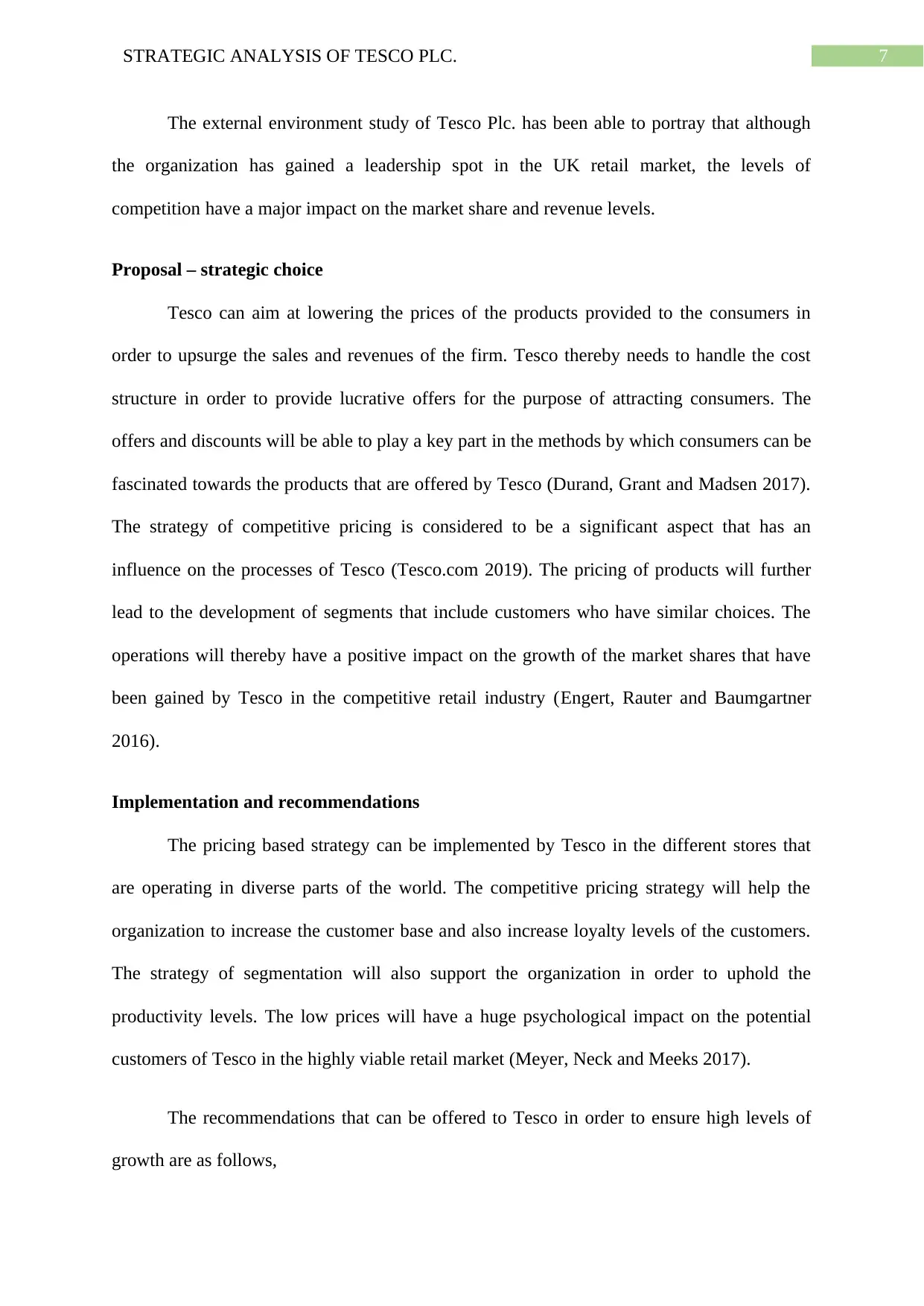
7STRATEGIC ANALYSIS OF TESCO PLC.
The external environment study of Tesco Plc. has been able to portray that although
the organization has gained a leadership spot in the UK retail market, the levels of
competition have a major impact on the market share and revenue levels.
Proposal – strategic choice
Tesco can aim at lowering the prices of the products provided to the consumers in
order to upsurge the sales and revenues of the firm. Tesco thereby needs to handle the cost
structure in order to provide lucrative offers for the purpose of attracting consumers. The
offers and discounts will be able to play a key part in the methods by which consumers can be
fascinated towards the products that are offered by Tesco (Durand, Grant and Madsen 2017).
The strategy of competitive pricing is considered to be a significant aspect that has an
influence on the processes of Tesco (Tesco.com 2019). The pricing of products will further
lead to the development of segments that include customers who have similar choices. The
operations will thereby have a positive impact on the growth of the market shares that have
been gained by Tesco in the competitive retail industry (Engert, Rauter and Baumgartner
2016).
Implementation and recommendations
The pricing based strategy can be implemented by Tesco in the different stores that
are operating in diverse parts of the world. The competitive pricing strategy will help the
organization to increase the customer base and also increase loyalty levels of the customers.
The strategy of segmentation will also support the organization in order to uphold the
productivity levels. The low prices will have a huge psychological impact on the potential
customers of Tesco in the highly viable retail market (Meyer, Neck and Meeks 2017).
The recommendations that can be offered to Tesco in order to ensure high levels of
growth are as follows,
The external environment study of Tesco Plc. has been able to portray that although
the organization has gained a leadership spot in the UK retail market, the levels of
competition have a major impact on the market share and revenue levels.
Proposal – strategic choice
Tesco can aim at lowering the prices of the products provided to the consumers in
order to upsurge the sales and revenues of the firm. Tesco thereby needs to handle the cost
structure in order to provide lucrative offers for the purpose of attracting consumers. The
offers and discounts will be able to play a key part in the methods by which consumers can be
fascinated towards the products that are offered by Tesco (Durand, Grant and Madsen 2017).
The strategy of competitive pricing is considered to be a significant aspect that has an
influence on the processes of Tesco (Tesco.com 2019). The pricing of products will further
lead to the development of segments that include customers who have similar choices. The
operations will thereby have a positive impact on the growth of the market shares that have
been gained by Tesco in the competitive retail industry (Engert, Rauter and Baumgartner
2016).
Implementation and recommendations
The pricing based strategy can be implemented by Tesco in the different stores that
are operating in diverse parts of the world. The competitive pricing strategy will help the
organization to increase the customer base and also increase loyalty levels of the customers.
The strategy of segmentation will also support the organization in order to uphold the
productivity levels. The low prices will have a huge psychological impact on the potential
customers of Tesco in the highly viable retail market (Meyer, Neck and Meeks 2017).
The recommendations that can be offered to Tesco in order to ensure high levels of
growth are as follows,
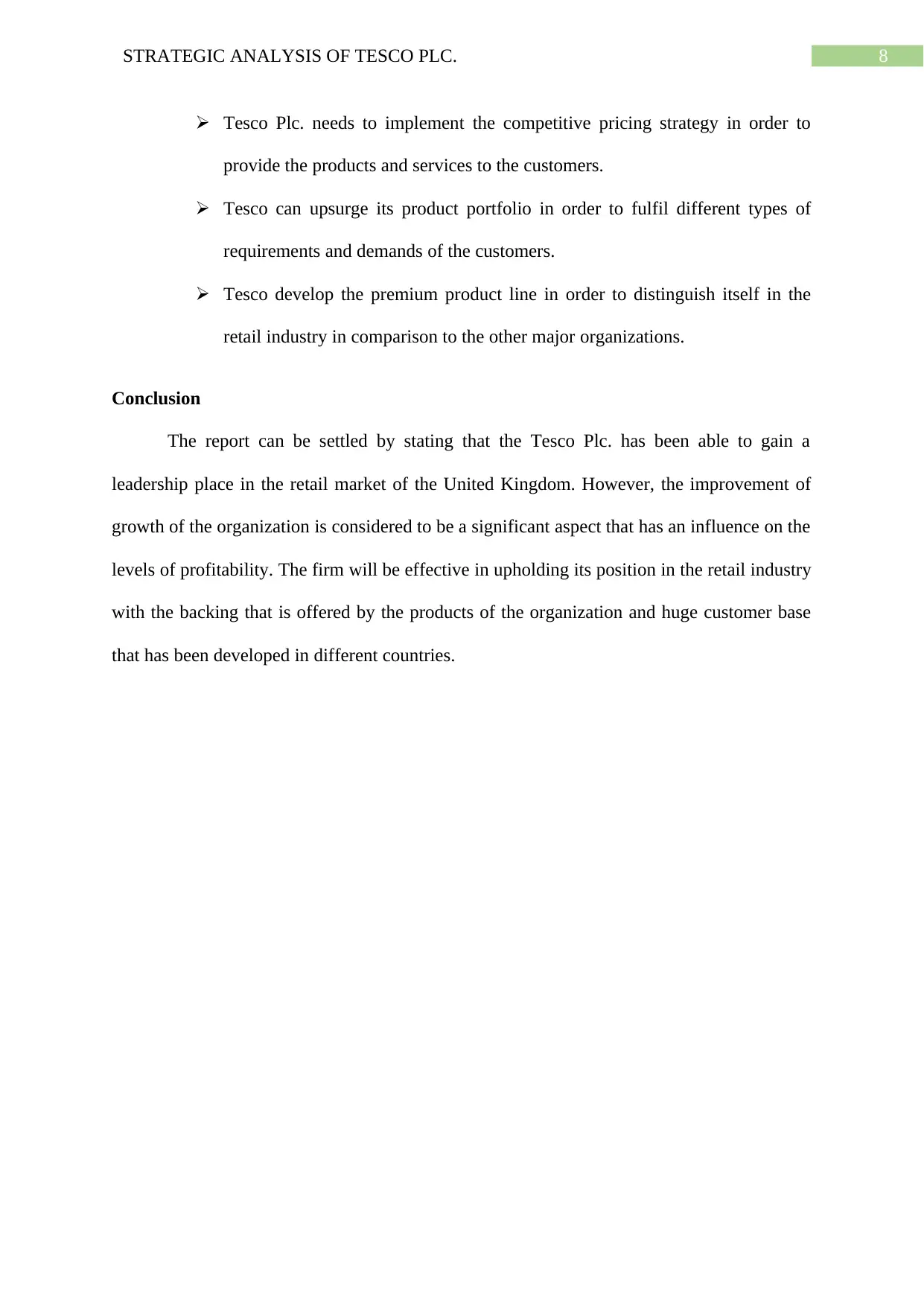
8STRATEGIC ANALYSIS OF TESCO PLC.
Tesco Plc. needs to implement the competitive pricing strategy in order to
provide the products and services to the customers.
Tesco can upsurge its product portfolio in order to fulfil different types of
requirements and demands of the customers.
Tesco develop the premium product line in order to distinguish itself in the
retail industry in comparison to the other major organizations.
Conclusion
The report can be settled by stating that the Tesco Plc. has been able to gain a
leadership place in the retail market of the United Kingdom. However, the improvement of
growth of the organization is considered to be a significant aspect that has an influence on the
levels of profitability. The firm will be effective in upholding its position in the retail industry
with the backing that is offered by the products of the organization and huge customer base
that has been developed in different countries.
Tesco Plc. needs to implement the competitive pricing strategy in order to
provide the products and services to the customers.
Tesco can upsurge its product portfolio in order to fulfil different types of
requirements and demands of the customers.
Tesco develop the premium product line in order to distinguish itself in the
retail industry in comparison to the other major organizations.
Conclusion
The report can be settled by stating that the Tesco Plc. has been able to gain a
leadership place in the retail market of the United Kingdom. However, the improvement of
growth of the organization is considered to be a significant aspect that has an influence on the
levels of profitability. The firm will be effective in upholding its position in the retail industry
with the backing that is offered by the products of the organization and huge customer base
that has been developed in different countries.
⊘ This is a preview!⊘
Do you want full access?
Subscribe today to unlock all pages.

Trusted by 1+ million students worldwide

9STRATEGIC ANALYSIS OF TESCO PLC.
References
Barros, I., Hernangómez, J. and Martin-Cruz, N., 2016. A theoretical model of strategic
management of family firms. A dynamic capabilities approach. Journal of Family Business
Strategy, 7(3), pp.149-159.
Daspit, J.J., Chrisman, J.J., Sharma, P., Pearson, A.W. and Long, R.G., 2017. A strategic
management perspective of the family firm: Past trends, new insights, and future
directions. Journal of Managerial Issues, 29(1), p.6.
Demir, R., Wennberg, K. and McKelvie, A., 2017. The strategic management of high-growth
firms: a review and theoretical conceptualization. Long Range Planning, 50(4), pp.431-456.
Dobbs, ME 2014, 'Guidelines for applying Porter's five forces framework: a set of industry
analysis templates', Competitiveness Review, vol. 24, no. 1, pp. 32–45.
Durand, R., Grant, R.M. and Madsen, T.L., 2017. The expanding domain of strategic
management research and the quest for integration. Strategic Management Journal, 38(1),
pp.4-16.
Dyer, J.H., Godfrey, P., Jensen, R. and Bryce, D., 2015. Strategic Management: Concepts
and Cases. Wiley Global Education.
Engert, S., Rauter, R. and Baumgartner, R.J., 2016. Exploring the integration of corporate
sustainability into strategic management: a literature review. Journal of cleaner
production, 112, pp.2833-2850.
Ethiraj, S.K., Gambardella, A. and Helfat, C.E., 2018. Theory in strategic
management. Strategic Management Journal, 39(6), pp.1529-1529.
References
Barros, I., Hernangómez, J. and Martin-Cruz, N., 2016. A theoretical model of strategic
management of family firms. A dynamic capabilities approach. Journal of Family Business
Strategy, 7(3), pp.149-159.
Daspit, J.J., Chrisman, J.J., Sharma, P., Pearson, A.W. and Long, R.G., 2017. A strategic
management perspective of the family firm: Past trends, new insights, and future
directions. Journal of Managerial Issues, 29(1), p.6.
Demir, R., Wennberg, K. and McKelvie, A., 2017. The strategic management of high-growth
firms: a review and theoretical conceptualization. Long Range Planning, 50(4), pp.431-456.
Dobbs, ME 2014, 'Guidelines for applying Porter's five forces framework: a set of industry
analysis templates', Competitiveness Review, vol. 24, no. 1, pp. 32–45.
Durand, R., Grant, R.M. and Madsen, T.L., 2017. The expanding domain of strategic
management research and the quest for integration. Strategic Management Journal, 38(1),
pp.4-16.
Dyer, J.H., Godfrey, P., Jensen, R. and Bryce, D., 2015. Strategic Management: Concepts
and Cases. Wiley Global Education.
Engert, S., Rauter, R. and Baumgartner, R.J., 2016. Exploring the integration of corporate
sustainability into strategic management: a literature review. Journal of cleaner
production, 112, pp.2833-2850.
Ethiraj, S.K., Gambardella, A. and Helfat, C.E., 2018. Theory in strategic
management. Strategic Management Journal, 39(6), pp.1529-1529.
Paraphrase This Document
Need a fresh take? Get an instant paraphrase of this document with our AI Paraphraser
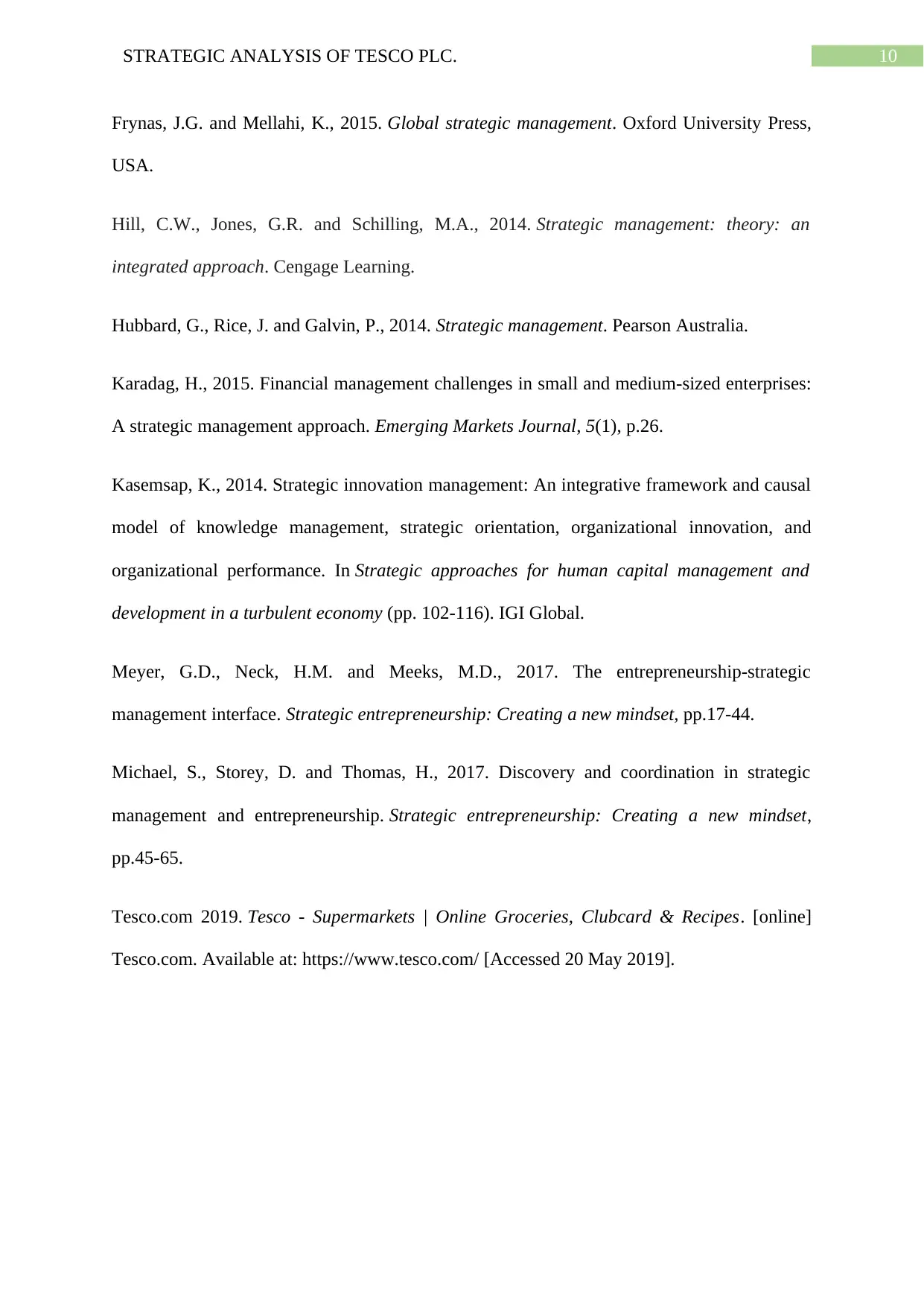
10STRATEGIC ANALYSIS OF TESCO PLC.
Frynas, J.G. and Mellahi, K., 2015. Global strategic management. Oxford University Press,
USA.
Hill, C.W., Jones, G.R. and Schilling, M.A., 2014. Strategic management: theory: an
integrated approach. Cengage Learning.
Hubbard, G., Rice, J. and Galvin, P., 2014. Strategic management. Pearson Australia.
Karadag, H., 2015. Financial management challenges in small and medium-sized enterprises:
A strategic management approach. Emerging Markets Journal, 5(1), p.26.
Kasemsap, K., 2014. Strategic innovation management: An integrative framework and causal
model of knowledge management, strategic orientation, organizational innovation, and
organizational performance. In Strategic approaches for human capital management and
development in a turbulent economy (pp. 102-116). IGI Global.
Meyer, G.D., Neck, H.M. and Meeks, M.D., 2017. The entrepreneurship‐strategic
management interface. Strategic entrepreneurship: Creating a new mindset, pp.17-44.
Michael, S., Storey, D. and Thomas, H., 2017. Discovery and coordination in strategic
management and entrepreneurship. Strategic entrepreneurship: Creating a new mindset,
pp.45-65.
Tesco.com 2019. Tesco - Supermarkets | Online Groceries, Clubcard & Recipes. [online]
Tesco.com. Available at: https://www.tesco.com/ [Accessed 20 May 2019].
Frynas, J.G. and Mellahi, K., 2015. Global strategic management. Oxford University Press,
USA.
Hill, C.W., Jones, G.R. and Schilling, M.A., 2014. Strategic management: theory: an
integrated approach. Cengage Learning.
Hubbard, G., Rice, J. and Galvin, P., 2014. Strategic management. Pearson Australia.
Karadag, H., 2015. Financial management challenges in small and medium-sized enterprises:
A strategic management approach. Emerging Markets Journal, 5(1), p.26.
Kasemsap, K., 2014. Strategic innovation management: An integrative framework and causal
model of knowledge management, strategic orientation, organizational innovation, and
organizational performance. In Strategic approaches for human capital management and
development in a turbulent economy (pp. 102-116). IGI Global.
Meyer, G.D., Neck, H.M. and Meeks, M.D., 2017. The entrepreneurship‐strategic
management interface. Strategic entrepreneurship: Creating a new mindset, pp.17-44.
Michael, S., Storey, D. and Thomas, H., 2017. Discovery and coordination in strategic
management and entrepreneurship. Strategic entrepreneurship: Creating a new mindset,
pp.45-65.
Tesco.com 2019. Tesco - Supermarkets | Online Groceries, Clubcard & Recipes. [online]
Tesco.com. Available at: https://www.tesco.com/ [Accessed 20 May 2019].
1 out of 11
Related Documents
Your All-in-One AI-Powered Toolkit for Academic Success.
+13062052269
info@desklib.com
Available 24*7 on WhatsApp / Email
![[object Object]](/_next/static/media/star-bottom.7253800d.svg)
Unlock your academic potential
Copyright © 2020–2025 A2Z Services. All Rights Reserved. Developed and managed by ZUCOL.




